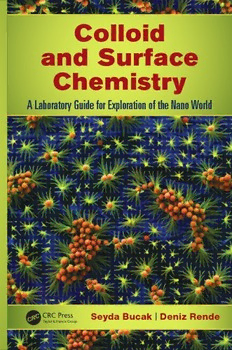
Colloid and Surface Chemistry : A Laboratory Guide for Exploration of the Nano World PDF
Preview Colloid and Surface Chemistry : A Laboratory Guide for Exploration of the Nano World
Surface & colloid chemiStry Colloid Colloid and Surface and Surface Chemistry Chemistry A Laboratory Guide for Exploration of the Nano World A Laboratory Guide for Exploration of the Nano World With principles that are shaping today’s most advanced technologies, from nanomedicine to electronic nanorobots, colloid and interface science has become a truly interdisciplinary field, integrating chemistry, physics, and biology. Colloid and Surface Chemistry: A Laboratory Guide for Exploration of the Nano World explains the basic principles of colloid and interface science through experiments that emphasize the fundamentals. It bridges the gap between the underlying theory and practical applications of colloid and surface chemistry. Separated into five chapters, the book begins by addressing research meth- odology, how to design successful experiments, and ethics in science. It also provides practical information on data collection and analysis, keeping a laboratory notebook, and writing laboratory reports. With each section written by a distinguished researcher, chapter 2 reviews common techniques for the characterization and analysis of colloidal structures, including surface tension measurements, viscosity and rheological measurements, electrokinetic methods, scattering and diffraction techniques, and microscopy. Chapters 3–5 provide 19 experiments, each including the purpose of the experiment, background information, pre-laboratory questions, step-by-step procedures, and post-laboratory questions. Chapter 3 contains experiments about colloids and surfaces, such as sedimentation, exploration of wetting phenomena, foam stability, and preparation of miniemulsions. Chapter 4 covers various techniques for the preparation of nanoparticles, including silver, magnetic, and silica nanoparticles. Chapter 5 demonstrates daily-life applications of colloid science, describing the preparation of food colloids, body wash, and body cream. K15257 ISBN-13: 978-1-4665-5310-1 90000 Seyda Bucak | Deniz Rende 9 781466 553101 K15257_Cover_mech.indd All Pages 11/11/13 3:46 PM Colloid and Surface Chemistry A Laboratory Guide for Exploration of the Nano World Colloid and Surface Chemistry A Laboratory Guide for Exploration of the Nano World Seyda Bucak | Deniz Rende Boca Raton London New York CRC Press is an imprint of the Taylor & Francis Group, an informa business CRC Press Taylor & Francis Group 6000 Broken Sound Parkway NW, Suite 300 Boca Raton, FL 33487-2742 © 2014 by Taylor & Francis Group, LLC CRC Press is an imprint of Taylor & Francis Group, an Informa business No claim to original U.S. Government works Version Date: 20140121 International Standard Book Number-13: 978-1-4665-5311-8 (eBook - PDF) This book contains information obtained from authentic and highly regarded sources. Reasonable efforts have been made to publish reliable data and information, but the author and publisher cannot assume responsibility for the validity of all materials or the consequences of their use. The authors and publishers have attempted to trace the copyright holders of all material reproduced in this publication and apologize to copyright holders if permission to publish in this form has not been obtained. If any copyright material has not been acknowledged please write and let us know so we may rectify in any future reprint. Except as permitted under U.S. Copyright Law, no part of this book may be reprinted, reproduced, transmit- ted, or utilized in any form by any electronic, mechanical, or other means, now known or hereafter invented, including photocopying, microfilming, and recording, or in any information storage or retrieval system, without written permission from the publishers. For permission to photocopy or use material electronically from this work, please access www.copyright. com (http://www.copyright.com/) or contact the Copyright Clearance Center, Inc. (CCC), 222 Rosewood Drive, Danvers, MA 01923, 978-750-8400. CCC is a not-for-profit organization that provides licenses and registration for a variety of users. For organizations that have been granted a photocopy license by the CCC, a separate system of payment has been arranged. Trademark Notice: Product or corporate names may be trademarks or registered trademarks, and are used only for identification and explanation without intent to infringe. Visit the Taylor & Francis Web site at http://www.taylorandfrancis.com and the CRC Press Web site at http://www.crcpress.com We dedicate this book to our life partners, who have been there for us Contents List of figures .....................................................................................................xi List of tables .....................................................................................................xix Preface ...............................................................................................................xxi Authors ............................................................................................................xxv Contributors .................................................................................................xxvii Symbols ..........................................................................................................xxix Chapter 1 Scientific research .......................................................................1 The research process .........................................................................................1 Ethics in science..................................................................................................2 Validity of research and documentation ...................................................3 Interactions with the scientific community ...............................................3 The needs and values of society .................................................................4 Design of experiments.......................................................................................5 Fundamentals of scientific computing ............................................................8 Nihat Baysal Dimensions and units ...................................................................................8 Unit conversions ..........................................................................................14 Significant figures .......................................................................................15 Errors in measurements .............................................................................16 Statistical significance .................................................................................17 Recording data: Keeping a good notebook ..................................................20 Presenting data: Writing a laboratory report ...............................................21 Cover page ....................................................................................................21 Table of contents ..........................................................................................21 Theoretical background .............................................................................21 Materials .......................................................................................................22 Procedure .....................................................................................................22 Experimental data, observations, and calculations ................................22 Graphs ...........................................................................................................22 Results and discussion ...............................................................................23 References .........................................................................................................23 vii viii Contents Chapter 2 Characterization techniques ...................................................27 Surface tension measurements .......................................................................27 Seyda Bucak Introduction .................................................................................................27 Static surface tension measurements ........................................................29 Shape and pressure methods ...........................................................30 Force methods ....................................................................................36 Dynamic surface tension measurements .................................................39 Maximum bubble pressure ..............................................................40 Spinning drop ....................................................................................40 Other methods .............................................................................................40 References .....................................................................................................40 Viscosity/rheological measurements ............................................................41 Patrick Underhill Introduction .................................................................................................41 Fluids versus solids and viscoelasticity .........................................41 Material functions .............................................................................42 Kinematics ..........................................................................................42 Capillary flow ..............................................................................................42 Newtonian profile ..............................................................................43 Weissenberg–Rabinowitsch method ...............................................43 Drag flow ......................................................................................................44 Parallel plates .....................................................................................44 Cone-and-plate ...................................................................................45 Couette flow .......................................................................................46 Additional considerations ..........................................................................47 Wall slip...............................................................................................47 Entrance effects ..................................................................................48 Edge effects .........................................................................................48 Instabilities .........................................................................................48 Torque sensitivity and instrument inertia .....................................49 Material segregation ..........................................................................49 Electrokinetic techniques ................................................................................49 Marek Kosmulski Introduction .................................................................................................49 Units, order of magnitude, accuracy, and precision ...............................50 Model of the interface .................................................................................50 Sources of the electric potential in the interfacial region ......................52 Description of the system ...........................................................................53 Classical electrokinetic phenomena .........................................................54 Electrophoresis ...................................................................................55 Electroosmosis and streaming potential (current) .......................62
